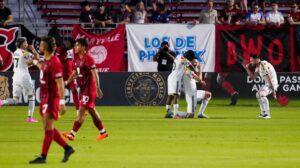The North American Soccer League is in trouble. The second tier league in the United States was already losing Minnesota United to MLS, and now they could see as many as four more sides depart the crumbling competition before the start of next season with only one more coming in to replace them.
The NASL Crisis and How to Fix It
The NASL is in full on crisis mode. The six year old league has had aspirations of joining MLS as a tier one league, as half baked as those dreams were to begin with. They are further than ever from achieving that designation. With the United Soccer League seeking second division status (and they have a very strong case), the NASL could possibly drop down to a third tier minor league.
The NASL has a lot of work to do if they want to survive as a league, let alone grow. They can start by abandoning their delusions of first tier status and focus on developing the league at a lower level.
Clubs Departing
Fort Lauderdale Strikers are currently run by the league as their bankrupt ownership has effectively abandoned the team. They have struggled to cover the paychecks for players and staff all season long. With the addition of Miami FC in the same media market, their attendance has dropped significantly. It’s difficult to imagine the Strikers stick around for much longer.
Rayo OKC has been nothing short of a disaster. Already the second minor league club in the city after the USL’s OKC Energy, the team’s financial backing comes from Rayo Vallecano in Spain, who was relegated from La Liga after last season. They may not want to fund the club with the need to return to the top tier so strong.
Now comes word that Ottawa Fury and Tampa Bay Rowdies could bolt the league for the technically lower tier USL. The third division certainly has a lot more going for it than the constantly in flux NASL. It has more teams closer together than the widespread NASL. It has the financial backing of MLS, which keeps it going strong despite the relative lack of exposure. As a result, it has, Austin Aztex aside, fewer clubs in financial trouble and a pretty strong track record of stability and growth.
They don’t harbor the first team aspirations of NASL, but they have proven to provide a stronger path to MLS for individual clubs. Only two NASL sides have successfully made the jump to the top, while four USL sides have moved up and plenty of talk surrounding Sacramento Republic, Saint Louis FC, and FC Cincinnati as potential MLS sides of the future.
The talk of a Canadian Premier League also can’t be ignored, as they could poach FC Edmonton one day.
Overall the NASL has seen five teams leave the league in six years and possibly another five, or even six, more on the way out soon.
Failing Expansion
NASL commissioner Bill Peterson continues to have high hopes for his young league. He is always looking for ways to expand the league into new markets, but has rarely delivered on that promise. Here’s a quote from yesterday’s Sports Illustrated article about the league’s situation:
“We’ve never had more serious conversations happening than we do right now, in more cities than we do right now,” Peterson said regarding expansion. “We’ve probably been in a process with maybe 40 groups. These are all people that have the wherewithal to do it. You start down through the process, depending on the group, depending on the city, can take as little as three to four months or as long as 18 months to complete.”
Peterson has been saying almost this exact same thing all season long. The only new team for the league next season, so far, is San Francisco Deltas, who are the league’s first west coast representative.
They are going to have to figure out a way to shorten that 18 month timeline if they want to avoid a major step backwards next year. They are at risk of going from a 12 team operation in the Fall 2016 season to a tiny eight team league for next spring.
There are plenty of markets that are ripe for NASL expansion. Cities targeted by MLS like Detroit, St. Louis, Cincinnati, San Antonio, and others have often come up. Whether it’s the nearly $5 million price tag to enter a minor league, the general financial instability, the insane travel requirements, or another unknown factor these markets are yet to take the NASL plunge.
How to Fix the NASL
Peterson likes to compare his league’s growing pains to the early years of MLS. They, too, experienced a revolving door of clubs coming and going before they hit their stride and became the more respected league they are today.
While the situations are similar, they are hardly the same. MLS didn’t have the level of competition from both above and below them on the pyramid. It was already on top and nobody was competing with them for that privilege. The USL was in its infancy back then and was in no way capable of eclipsing them. Nowadays, the NASL has the juggernaut of MLS in front of them and the better run, more stable USL below, and set to surpass, them in the near future.
That doesn’t mean the NASL is dead in the water. They simply need to slow down and realize that their first division dreams aren’t coming true, ever. Nothing short of a merger with MLS (and probably USL, too, but that’s for another article) will make that happen. In fact, they are probably going to have to take their lumps and accept a demotion to third tier status.
Once they do that, they can start over with a more USL-like model. The should focus on expanding to smaller markets without professional soccer instead of trying to compete with the other leagues like they did in Miami and Oklahoma City. They should keep their league compact at the restart, but avoid crowding themselves out of markets they already exist in. Adding Miami FC may have been a nice touch, but they already had a team in South Florida, and now that team has gone bankrupt.
They will also have to bend over backwards to maintain their two remaining flagship franchises, New York Cosmos and Indy Eleven, or else the league could slip further and further away from viability.
Overall, the NASL is not done for. They just need to take a step back and realize that they aren’t an alternative to MLS, they aren’t the preeminent minor soccer league in the USA, and they aren’t going to become a great product without a ton of hard work.






